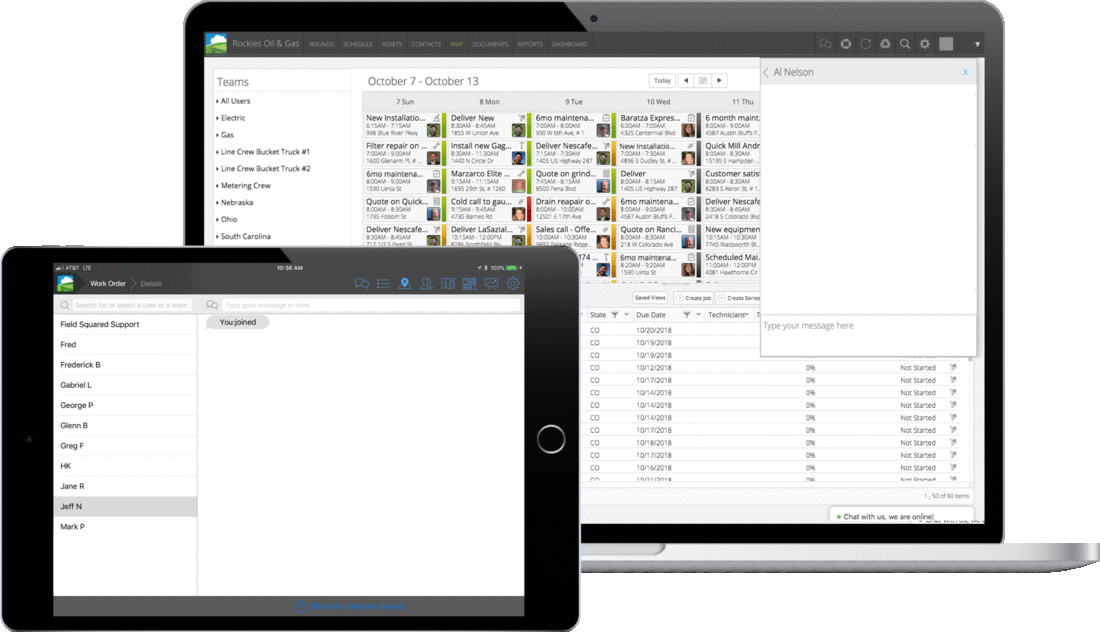Sun Valley Solar Doubles Efficiency and Expands Capabilities
"We can now handle 70 to 100 work orders per case manager, thanks to the streamlined process with Field Squared."
- Jim Hutson, Commercial and Residential O&M Manager, Sun Valley Solar.
Manage your entire field operations and enable staff, contractors and crews while tracking everything in real-time.

Field Squared is the industry’s first unified Field Service Automation Platform. As a cloud-based, software-as-a-service (SaaS) solution, Field Squared is flexible, scalable and purpose-built to optimize the efficiency of your mobile field service workforce. Field Squared enables enterprises to digitally transform, automate and streamline their field service operations, from the frontline to third-party, back-office systems. The powerful Platform delivers predictive analytics for proactive planning as well as interoperability across existing business systems, including legacy solutions, without the need for any software development or ongoing application maintenance.
Unlike other single-solution software on the market, the Field Squared Field Service Automation Platform is easily configurable to your business needs now and in the future, across any industry. Easily configurable means you’re up and running quickly, realizing field efficiency gains faster.
With a web-based application for operations managers, supervisors and dispatchers, as well as a mobile application for your field workforce, Field Squared automates your field operations processes to help you do more with less or square your productivity, all without actually adding a physical headcount.
There are three levels of the platform available - Mobile Workforce Management (MWM), Field Service Management (FSM) and Enterprise Asset Management (EAM).

The Field Squared Platform transforms field service management with automated, real-time analytics, reporting, and business intelligence. Effortlessly track key performance indicators and monitor the health of your operations. Reduce travel time, optimize work order efficiency, and leverage predictive drive time data to save fuel costs. Efficiently track mileage for compliance and gain comprehensive insights into your field operations from a single, powerful, unified dashboard. Field Squared empowers you to measure, track, and analyze every aspect of your field service processes, driving efficiency and enhancing overall performance.
Watch the 90-second explainer video to learn how Field Squared works across your field service, enterprise asset, and mobile workforce management needs in one unified solution.
"We can now handle 70 to 100 work orders per case manager, thanks to the streamlined process with Field Squared."
- Jim Hutson, Commercial and Residential O&M Manager, Sun Valley Solar.
“We've scaled our company up by 300% over seven years, which probably wouldn't have been doable without Field Squared.” - Jim Kent, a Market Vice President Operations, Segra
Read Case Study"We have scaled from doing one to two installs a day to 20 without a single headcount hire."
- Justin Nelson, COO, EVP Engineering and Operations, HyperFiber
"Field Squared has transformed our field operations, allowing us to complete more projects with greater efficiency."
- Sean O'Brien, Market VP of Operations at Oregon Aerial Construction
"Based on our initial rollout, we have already saved an annual amount of $250,000 in overhead costs."
- William Morgan, Implementation Specialist, Great Plains Gas Compression
"Since we've switched to Field Squared, all of our customer responses have been very positive."
- Jim Foley, CFO at Sea Tow
Read MoreGet in touch with us for a live demo.